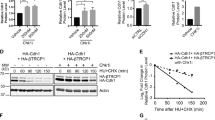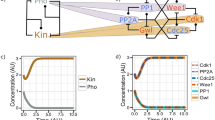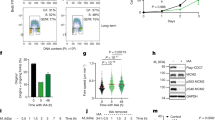Abstract
Checkpoints maintain the order and fidelity of events of the cell cycle by blocking mitosis in response to unreplicated or damaged DNA1. In most species this is accomplished by preventing activation of the cell-division kinase Cdc2, which regulates entry into mitosis2,3,4,5. The Chk1 kinase, an effector of the DNA-damage checkpoint, phosphorylates Cdc25, an activator of Cdc2 (6–11). Phosphorylation of Cdc25 promotes its binding to 14-3-3 proteins, preventing it from activating Cdc2 (ref. 8). Here we propose that a similar pathway is required for mitotic arrest in the presence of unreplicated DNA (that is, in the replication checkpoint) in fission yeast. We show by mutagenesis that Chk1 functions redundantly with the kinase Cds1 at the replication checkpoint and that both kinases phosphorylate Cdc25 on the same sites, which include serine residues at positions 99, 192 and 359. Mutation of these residues reduces binding of 14-3-3 proteins to Cdc25 in vitro and disrupts the replication checkpoint in vivo. We conclude that both Cds1 and Chk1 regulate the binding of Cdc25 to 14-3-3 proteins as part of the checkpoint response to unreplicated DNA.
This is a preview of subscription content, access via your institution
Access options
Subscribe to this journal
Receive 51 print issues and online access
$199.00 per year
only $3.90 per issue
Buy this article
- Purchase on Springer Link
- Instant access to full article PDF
Prices may be subject to local taxes which are calculated during checkout





Similar content being viewed by others
References
Hartwell, L. H. & Weinert, T. A. Checkpoints: controls that ensure the order of cell cycle events. Science 246, 629–634 (1989).
Enoch, T. & Nurse, P. Mutation of fission yeast cell cycle control genes abolishes dependence of mitosis on DNA replication. Cell 60, 665–673 (1990).
Jin, P., Gu, Y. & Morgan, D. O. Role of inhibitory Cdc2 phosphorylation in radiation-induced G2 arrest in human cells. J. Cell Biol. 134, 963–970 (1996).
O'Connell, M. J., Raleigh, J. M., Verkade, H. M. & Nurse, P. Chk1 is a wee1 kinase in the G2 DNA damage checkpoint inhibiting cdc2 by Y15 phosphorylation. EMBO J. 16, 545–554 (1997).
Rhind, N., Furnari, B. & Russell, P. Cdc2 tyrosine phosphorylation is required for the DNA damage checkpoint in fission yeast. Genes Dev. 11, 504–511 (1997).
Walworth, N., Davey, S. & Beach, D. Fission yeast chk1 protein kinase links the rad checkpoint pathway to cdc2. Nature 363, 368–371 (1993).
Walworth, N. C. & Bernards, R. rad-dependent responses of the chk1-encoded protein kinase at the DNA damage checkpoint. Science 271, 353–356 (1996).
Peng, C.-Y. et al. Mitotic- and G2-checkpoint control: regulation of 14-3-3 protein binding by phosphorylation of Cdc25C on serine 216. Science 277, 1501–1505 (1997).
Furnari, B., Rhind, N. & Russell, P. Cdc25 mitotic inducer targeted by Chk1 DNA damage checkpoint kinase. Science 277, 1495–1497 (1997).
Sanchez, Y. et al. Conservation of the Chk1 checkpoint pathway in mammals: linkage of DNA damage to Cdk regulation via Cdc25. Science 277, 1497–1501 (1997).
Al-Khodairy, F. et al. Identification and characterization of new elements involved in checkpoint and feedback controls in fission yeast. Mol. Biol. Cell 5, 147–160 (1994).
Murakami, H. & Okayama, H. Akinase from fission yeast responsible for blocking mitosis in S phase. Nature 374, 817–819 (1995).
Francesconi, S., Grenon, M., Bouvier, D. & Baldacci, G. p56chk1 protein kinase is required for the DNA replication checkpoint at 37 °C in fission yeast. EMBO J. 16, 1332–1341 (1997).
Uchiyama, M., Galli, I., Griffiths, D. J. F. & Wang, T. S.-F. Anovel mutant allele of Schizosaccharomyces pombe rad26 defective in monitoring S-phase progression to prevent premature mitosis. Mol. Cell. Biol. 17, 3103–3115 (1997).
Sibon, O. C. M., Stevenson, V. A. & Theurkauf, W. E. DNA-replication checkpoint control at the Drosophila midblastula transition. Nature 388, 93–97 (1997).
Lindsay, H. D. et al. Sphase-specific activation of Cds1 kinase defines a subpathway of the checkpoint response in Schizosaccharomyces pombe. Genes Dev. 12, 382–395 (1998).
Boddy, M. N., Furnari, B., Mondesert, O. & Russell, P. Replication checkpoint enforced by kinases Cds1 and Chk1. Science 280, 909–912 (1998).
Enoch, T., Carr, A. M. & Nurse, P. Fission yeast genes involved in coupling motisis to completion of DNA replication. Genes Dev. 6, 2035–2046 (1992).
Muslin, A. J., Tanner, J. W., Allen, P. M. & Shaw, A. S. Interaction of 14-3-3 with signaling proteins is mediated by the recognition of phosphoserine. Cell 84, 889–897 (1996).
Yaffe, M. B. et al. The structural basis for 14-3-3: phosphopeptide binding specificity. Cell 91, 961–971 (1997).
Forbes, K. C., Humphrey, T. & Enoch, T. Suppressors of Cdc25p overexpression identify two pathways that influence the G2/M checkpoint in fission yeast. Genetics (in the press).
Basi, G., Schmid, E. & Maundrell, K. TATA box mutations in the Schizosaccharomyces pombe nmt1 promoter affect transcription efficiency but not the transcription start point or the thiamine repressibility. Gene 123, 131–136 (1993).
Ogg, S., Gabrielli, B. & Piwnica-Worms, H. Purification of a serine inase that associates with and phosphorylates human Cdc25C on serine 216. J. Biol. Chem. 269, 30461–30469 (1994).
Liu, F., Stanton, J. J., Wu, Z. & Piwnica-Worms, H. The human Myt1 kinase preferentially phosphorylates Cdc2 on threonine 14 and localizes to the endoplasmic reticulum and Golgi complex. Mol. Cell. Biol. 17, 571–583 (1997).
van der Geer, P. & Hunter, T. Phosphopeptide mapping and phsophoamino acid analysis by electrophoresis and chromatography on thin-layer cellulose plates. Electrophoresis 15, 544–554 (1994).
Moreno, S., Klar, A. & Nurse, P. in Guide to Yeast Genetics and Molecular Biology (eds Guthrie, C. & Fink, G. R.) 795–823 (Academic, San Diego, 1991).
Lee, M. S., Enoch, T. & PiwnicapWorms, H. Mik1+ encodes a tyrosine kinase that phosphorylates p34cdc2 on tyrosine 15. J. Biol. Chem. 269, 30530–30537 (1994).
Maundrell, K. nmt1 of fission yeast. J. Biol. Chem. 265, 10857–10864 (1990).
Kostrub, C. et al. Molecular analysis of hus1+, a fission yeast gene required for S-M and DNA damage checkpoints. Mol. Gen. Genet. 254, 389–399 (1997).
Moreno, S., Nurse, P. & Russell, P. Regulation of mitosis by cyclic accumulation of p80cdc25 mitotic inducer in fission yeast. Nature 344, 549–552 (1990).
Acknowledgements
We thank H. Murakami and H. Okayama for pcL-cds1; A. Khokhlatchev and M.Cobb for pBB131; A. M. Carr for strains and plasmids; A. M. Carr and H. Lindsay for discussing construction of the cds1 −chk1 − mutant. This work was supported in part by the NIH. H.P.-W. is an Associate Investigator of the Howard Hughes Medical Institute.
Author information
Authors and Affiliations
Corresponding author
Supplementary Information
Rights and permissions
About this article
Cite this article
Zeng, Y., Forbes, K., Wu, Z. et al. Replication checkpoint requires phosphorylation of the phosphatase Cdc25 by Cds1 or Chk1. Nature 395, 507–510 (1998). https://doi.org/10.1038/26766
Received:
Accepted:
Issue Date:
DOI: https://doi.org/10.1038/26766
This article is cited by
-
Caffeine as a tool for investigating the integration of Cdc25 phosphorylation, activity and ubiquitin-dependent degradation in Schizosaccharomyces pombe
Cell Division (2020)
-
The G2-to-M transition from a phosphatase perspective: a new vision of the meiotic division
Cell Division (2020)
-
S-phase checkpoint regulations that preserve replication and chromosome integrity upon dNTP depletion
Cellular and Molecular Life Sciences (2017)
-
Regulation of microRNA during cardiomyocyte maturation in sheep
BMC Genomics (2015)
-
Probing the cell death signaling pathway of HepG2 cell line induced by copper-1,10-phenanthroline complex
BioMetals (2014)
Comments
By submitting a comment you agree to abide by our Terms and Community Guidelines. If you find something abusive or that does not comply with our terms or guidelines please flag it as inappropriate.



